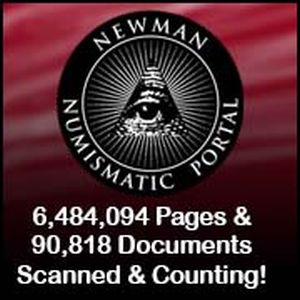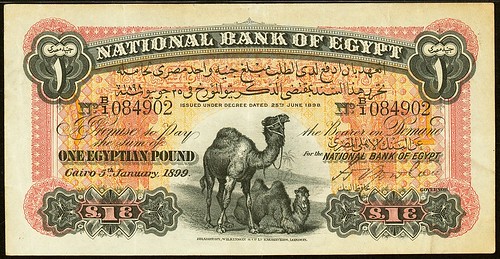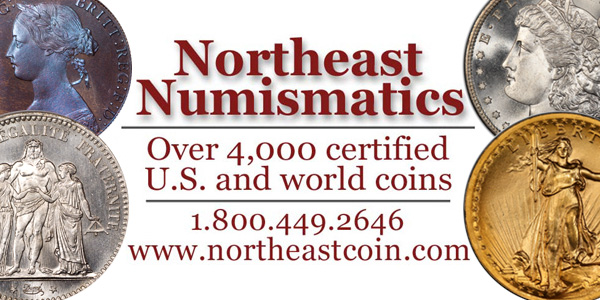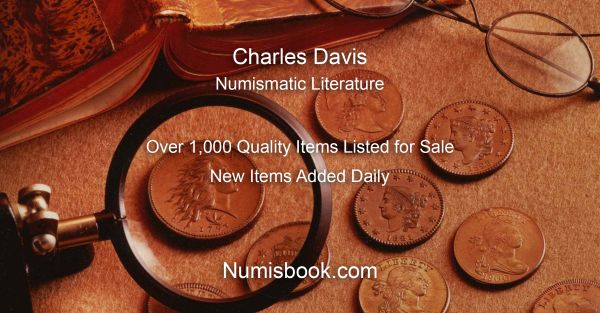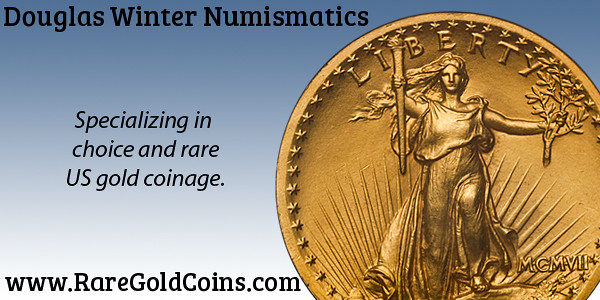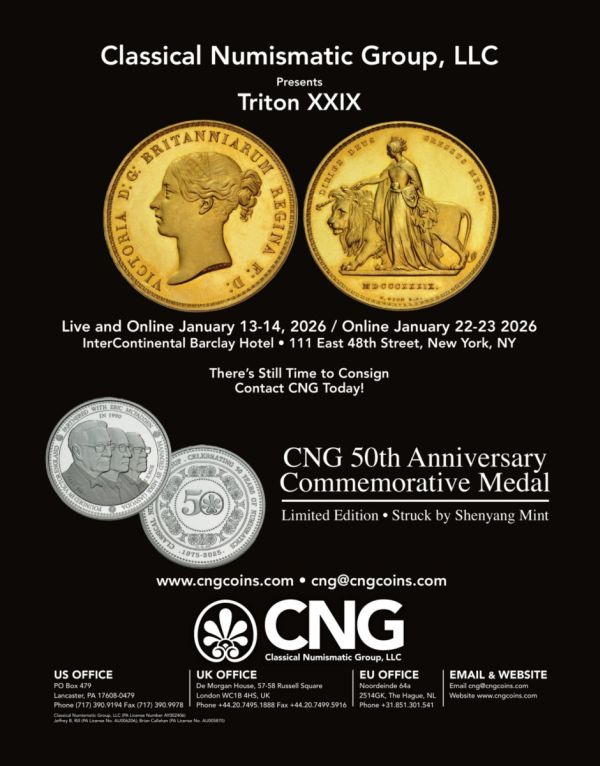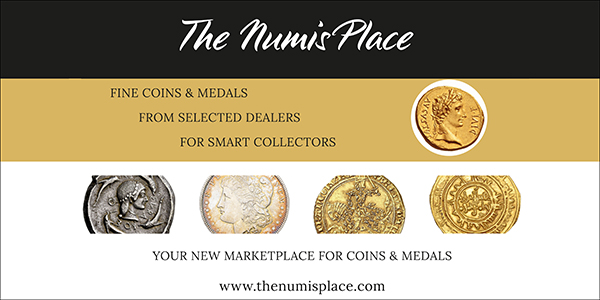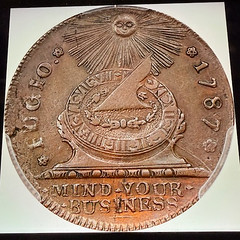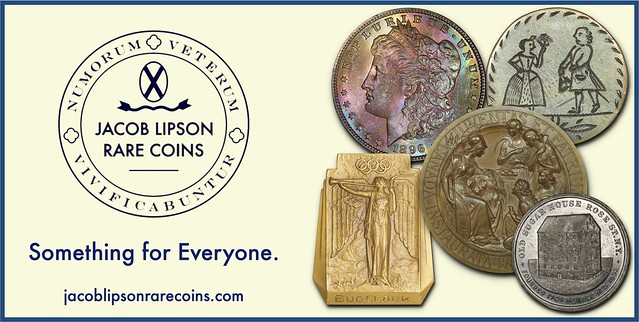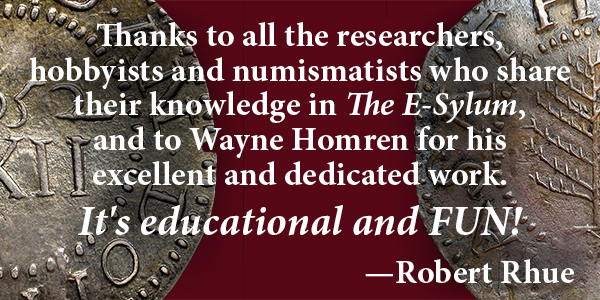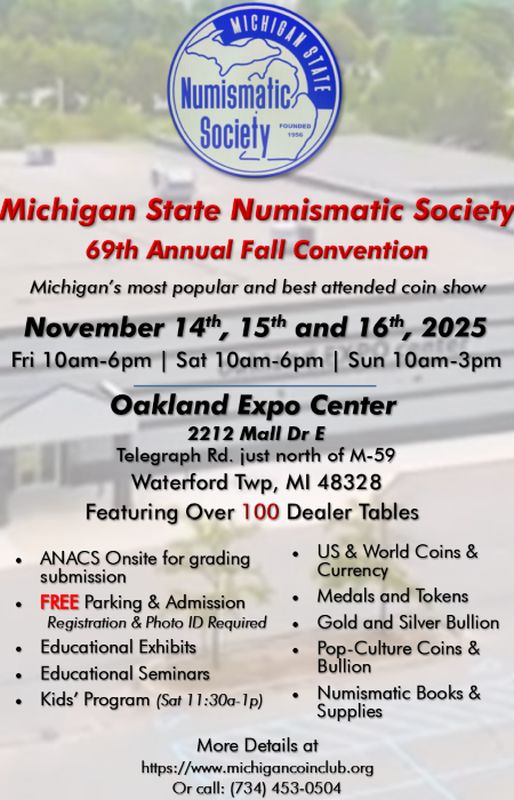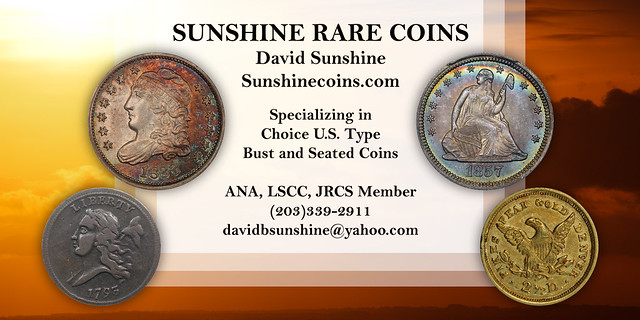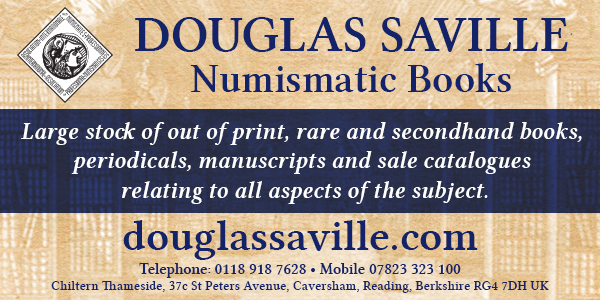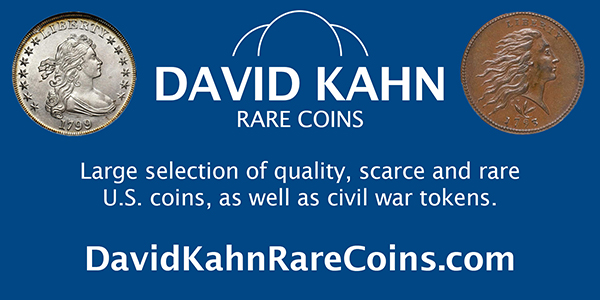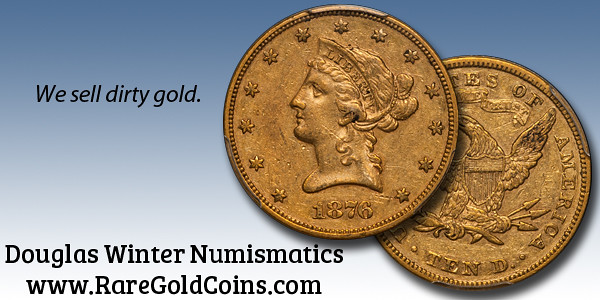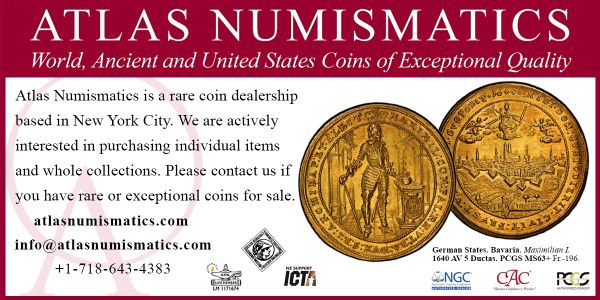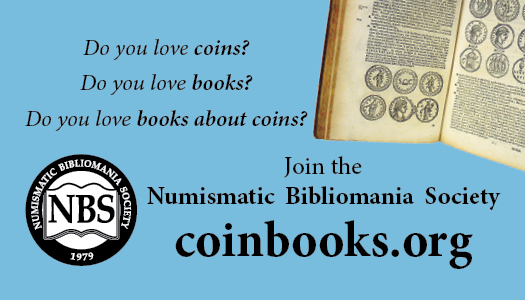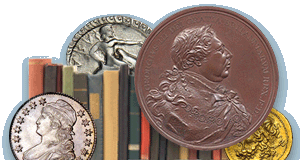
Visit our NBS Sponsors
About UsThe Numismatic Bibliomania Society is a non-profit association devoted to the study and enjoyment of numismatic literature. For more information please see our web site at coinbooks.org SubscriptionsThose wishing to become new E-Sylum subscribers can go to the following web page
Subscribe
MembershipThere is a membership application available on the web site Membership Application To join, print the application and return it with your check to the address printed on the application. Print/Digital membership is $40 to addresses in the U.S., and $60 elsewhere. A digital-only membership is available for $25. For those without web access, write to: Jeff Dickerson, Treasurer AsylumFor Asylum mailing address changes and other membership questions, contact Jeff at this email address: treasurer@coinbooks.org SubmissionsTo submit items for publication in The E-Sylum, write to the Editor at this address: whomren@gmail.com BUY THE BOOK BEFORE THE COINSale Calendar |
- WAYNE'S WORDS: THE E-SYLUM OCTOBER 12, 2025
- KOLBE & FANNING WEB SALE NUMBER 5
- THE 2025 NBS SYMPOSIUM
- NEW BOOK: CENTS AND HALF CENTS OF MASSACHUSETTS
- NEW BOOK: INDIAN PEACE MEDALS AT ANS
- NEW BOOKS: U.S. LARGE CENTS, 2ND EDITION
- NEW BOOK: TREASURES OF THE OCCULT
- PERIODICAL: TAMS JOURNAL SEP-OCT 2025
- NEWMAN PORTAL SCANS LINCOLN SENSE
- VIDEO: LOOKING AT A DOLLAR BILL
- NOTES FROM E-SYLUM READERS: OCTOBER 12, 2025
- THE ARTS OF MONEY: ADOLPH WEINMAN
- CONECA TO OFFER ERROR & VARIETY EXAMINATION
- ERROR COIN PUBLICATION GALLERY
- VOCABULARY TERM: ROTATED DIE
- MORE 1804 DOLLAR STORIES
- 1804 DOLLAR FAKES AND REPLICAS
- 1804 DOLLAR OFFERED ON EBAY
- U.S. MINT 1804 DOLLAR IN GOLD
- SBG RICHARD AUGUST COLONIAL CURRENCY SELECTIONS
- THE DEAN OAKES COLLECTION, PART ONE
- HERITAGE: OCTOBER 2025 WORLD PAPER MONEY
- FRED HOLABIRD'S GRAND FINALE AUCTION
- LIVING AMERICANS ON US COINS
- THE FIRST LIVING PERSON ON A ROMAN COIN
- WOULD THE 2026 TRUMP COIN BE LEGAL?
- PHILIPPINE ABACA FIBER FOR CURRENCY?
- THE 2025 GOLD RUSH
- PAUL KRUGER'S NUMISMATIC LEGACY
- LOOSE CHANGE: OCTOBER 12, 2025
- ABOUT THIS ISSUE: OCTOBER 12, 2025
Content presented in The E-Sylum is not necessarily researched or independently fact-checked, and views expressed do not necessarily represent those of the Numismatic Bibliomania Society.
WAYNE'S WORDS: THE E-SYLUM OCTOBER 12, 2025
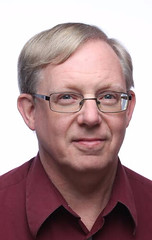 Thank you for reading The E-Sylum. If you enjoy it, please send me the email addresses of friends you think may enjoy it as well and I'll send them a subscription. Contact me at whomren@gmail.com anytime regarding your subscription, or questions, comments or suggestions about our content.
Thank you for reading The E-Sylum. If you enjoy it, please send me the email addresses of friends you think may enjoy it as well and I'll send them a subscription. Contact me at whomren@gmail.com anytime regarding your subscription, or questions, comments or suggestions about our content.
This week we open with a numismatic literature sale, the NBS Symposium, six new books, a periodical, updates from the Newman Numismatic Portal, and more.
Other topics this week include Indian Peace medals, Lincoln Cents, Adolph Weinman, error coins, rotated dies, 1804 dollar stories, fakes and replicas, paper money sale selections, the first living person on a Roman coin, the 2025 gold rush, and Paul Kruger's numismatic legacy.
To learn more about the origin of Whitman Publishing, the Massachusetts Copper Mint, history's unorthodox money, American Token manufacturers, symbology of the U.S. dollar bill, uncut sheet pranksters, the Arts of Money lecture series, the 1804 dollar in gold, the Dean Oakes Collection of U.S. Type Notes, Fred Holabird's Grand Finale auction, living Americans on U.S. coinage, and Philippine abaca fiber, read on. Have a great week, everyone!
Wayne Homren
Editor, The E-Sylum
KOLBE & FANNING WEB SALE NUMBER 5
Numismatic Booksellers Kolbe & Fanning have announced a new web sale on Wednesday, October 22, 2025. Here's the announcement. -Editor
We will be holding Web Sale #5 of Numismatic Books on Wednesday, October 22, starting at 12:00 PM Eastern. This sale focuses on inexpensive but useful books, catalogues and other publications on coins from all times and places. It will take place live online, in much the same format as our Premier Auctions, and all lots in the Web Sale will begin at a very low $10 opening bid.
Bidders may register for the sale, browse lots, and place absentee bids beginning immediately at bid.numislit.com.
THE 2025 NBS SYMPOSIUM
The 2025 NBS Symposium took place at the American Numismatic Association convention in Oklahoma City, on Thursday, August 21, at 1PM. This year's event featured Jeff Garrett (shown below) speaking on the Guide Book of U.S. Coins, for which he is the Senior Editor. Numismatic Bibliomania Society President Len Augsburger submitted this report. Thank you. -Editor
 The corporate origins of Whitman Publishing, the current owner of the Guide Book,
begin in 1907, as West Side Printing in Racine, WI. The company's name was changed
to Western Printing & Lithography in 1910, and the firm found a foothold in the
children's book business. The more familiar Whitman Publishing brand, technically a
subsidiary of Western Printing, was launched in 1916.
The corporate origins of Whitman Publishing, the current owner of the Guide Book,
begin in 1907, as West Side Printing in Racine, WI. The company's name was changed
to Western Printing & Lithography in 1910, and the firm found a foothold in the
children's book business. The more familiar Whitman Publishing brand, technically a
subsidiary of Western Printing, was launched in 1916.
In addition to books, the company developed die cutting capability and produced board games, playing cards, and eventually coin boards. Sometime in the mid-1930s Whitman acquired the rights to the coin board as invented by Joseph Kent Post, and the rest, as they say, is history. Garrett noted that the soon-to-be ubiquitous coin board democratized coin collecting and opened the "hobby of kings" to the general public. Jeff himself was introduced to coin collecting via the Whitman folder, in 1969.
Richard Yeo, aka R. S. Yeoman, joined Whitman in 1932 and took charge of the coin board business. Soon the audience consisted of millions of coin collectors, but with little published information to guide them. J. W. Scott, B. Max Mehl, and others, took furtive steps towards creating catalogs and price guides, but none of these gained a mass following. While Mehl's Star Rare Coin Encyclopedia sold well, it remained a "prices paid for" list rather than an authoritative and concise reference.
NEW BOOK: CENTS AND HALF CENTS OF MASSACHUSETTS
Mike Packard's book on the Massachusetts coppers has been published. Kolbe & Fanning Booksellers calls it "long-awaited" in the numismatic understatement of the century - collectors have been waiting since 1920 for a new book on the topic, and there's no one better to write it - Mike has been studying and collecting these for decades. Congratulations! Orders may be placed with either Kolbe & Fanning Numismatic Booksellers (https:www.numislit.com) or Charles Davis Numismatic Literature (https:www.numisbook.com). -Editor
 THE CENTS AND HALF CENTS OF MASSACHUSETTS
THE CENTS AND HALF CENTS OF MASSACHUSETTS
Packard, Michael
2025. 310 pages, illustrated.
The long-awaited standard reference to the Massachusetts copper coinage of 1787–1788, providing detailed historical background as well as a carefully written and well-illustrated attribution guide to the die varieties of the series. The first major study of these coins since Hillyer Ryder's "The Copper Coins of Massachusetts" was published in 1920.
Here's the book's Introduction. -Editor
NEW BOOK: INDIAN PEACE MEDALS AT ANS
The ANS has published a new catalogue of their Indian Peace Medal collection, written by Oliver Hoover. -Editor
 The American Numismatic Society is pleased to announce the release of an exciting new book in our Studies in Medallic Art series: "Let Us Have Peace" A Catalogue of Indian Peace Medals at the American Numismatic Society.
The American Numismatic Society is pleased to announce the release of an exciting new book in our Studies in Medallic Art series: "Let Us Have Peace" A Catalogue of Indian Peace Medals at the American Numismatic Society.
With 535 pages, including more than 600 images printed in full color, Let Us Have Peace offers a detailed numismatic, art- and socio-historical discussion of 302 Indian peace medals and related objects that entered the cabinet of the American Numismatic Society between 1883 and 2018. The medals represent an important and often under-utilized resource for the history of relationships between the Native peoples of North America and the colonial powers of France, Great Britain, and Spain, as well as their successors, Canada and the United States of America. Despite being inanimate objects of silver and copper, the Indian peace medals in the ANS collection are incomparable storytellers, each offering its own tale of the past that gives us insight into the remarkable lives of the medals' creators, distributors, and recipients.
NEW BOOKS: U.S. LARGE CENTS, 2ND EDITION
Robert Powers has completed the 2nd Edition of his Early Large Cent book, newly expanded, much improved, and now called the Professional Edition. It is available in three volumes: 1793-1795; 1796-1799; 1800-1814, and available from David Kahn Rare Coins, Inc. -Editor
This is the follow-up publication to the author's 2020 publication, U.S. Large Cents 1793-1814 Variety Identification Guide (the "blue book"). This is the first of three new volumes which are designed in the same familiar format, though with important updates, greatly improved photos, and much more.
This guide is entitled the Professional Edition as it is primarily targeted at users who already have (or aspire to have) an intermediate or advanced level of expertise in attributing Early Date Large Cents, or who have expertise in other series and want to take their underlying knowledge of attribution methods from elsewhere into this series.
NEW BOOK: TREASURES OF THE OCCULT
Baldwin's Head of Ancient Coins Dominic Chorney has published a book embracing weird, magic and occult themes in numismatics. Here's information from the publisher's website. -Editor
 Step into the realm of mysterious money in Dominic Chorney's latest publication: Treasures of the Occult. When you're done with this book, you might never look at the coins in your pocket the same way again.
Step into the realm of mysterious money in Dominic Chorney's latest publication: Treasures of the Occult. When you're done with this book, you might never look at the coins in your pocket the same way again.
Just in time for Halloween, Treasures of the Occult will be released in October 2025. Only 800 first edition copies will be printed.
The mysteries of the world aren't confined to haunted houses, spooky woods, and dark tunnels. They're everywhere. They even haunt the money we spend. For over 2,000 years, since the beginnings of currency in the ancient world, coins and treasure have been associated with unusual events, frightening creatures and occult magic. For the first time, Treasures of the Occult will take the reader on a journey through the world of unusual coins: treasure magic, secret societies, monsters, UFOs and occult imagery. These are just a few of the many topics explored in the publication, which will be of interest to coin collectors, historians, and ghost hunters alike. Featuring a foreword by Dr. Ciaran O'Keeffe.
PERIODICAL: TAMS JOURNAL SEP-OCT 2025
The September-October issue of The TAMS Journal has been published by the Token and Medal Society. If you have even the slightest interest in the topics, you need to be a member. See the link below for more information. -Editor
Table of Contents
The Calvin Coolidge Inaugural Medal
Harry Waterson
Philip Whitlock and His Old Virginia Cheroots
David E. Schenkman
The Home Insurance Company, New York; Counting the Years
Harry Waterson
THE BOOK BAZARRE
NEWMAN PORTAL SCANS LINCOLN SENSE
The latest addition to the Newman Numismatic Portal is Lincoln Sense from the Society of Lincoln Cent Collectors. Project Coordinator Len Augsburger provided the following report. -Editor
Newman Portal Scans Lincoln Sense
 With assistance from Gary Rosner and Chuck Daughtrey, Newman Portal has digitized a run of Lincoln Sense, the newsletter of the Society of Lincoln Cent Collectors (SLCC), covering the years from 1996 to 2007. The SLCC was formed in 1982 by Dr. Sol Taylor, who for many years acted as president and editor. In later years, Chuck Daughtrey served the organization.
With assistance from Gary Rosner and Chuck Daughtrey, Newman Portal has digitized a run of Lincoln Sense, the newsletter of the Society of Lincoln Cent Collectors (SLCC), covering the years from 1996 to 2007. The SLCC was formed in 1982 by Dr. Sol Taylor, who for many years acted as president and editor. In later years, Chuck Daughtrey served the organization.
While Lincoln Sense provided liberal coverage of commercial matters such as pricing and grading, the newsletter also included articles on new discoveries and research. Occasional tidbits such as a 1981 handwritten letter from Stewart Blay (April 2005 issue), who formed the ne plus ultra Lincoln cent collection, are present. The September 1998 issue reprinted U.S. Mint correspondence related to Victor D. Brenner, the Lincoln cent designer, this material contributed by Carl Waltz.
VIDEO: LOOKING AT A DOLLAR BILL
The David Lisot Video Library on the Newman Numismatic Portal can be found at:
https://nnp.wustl.edu/library/multimediadetail/522852
We highlight one of his videos each week in The E-Sylum. Here's one from 2009 with Carl Schwenker speaking about the symbology of the U.S. dollar bill. -Editor
NOTES FROM E-SYLUM READERS: OCTOBER 12, 2025
Stolen Fugio
Tony Terranova reported that this Fugio was stolen in the USPS between Florida and New York, and should be identifiable by the surface defects. Please keep an eye out! -Editor
Other topics this week include the 2010 south Africa 50 Cents coin, a 1680 German coinage proclamation, the Columbian Exposition designer medal, and uncut sheet pranksters. -Editor
THE ARTS OF MONEY: ADOLPH WEINMAN
Carlos Kearns submitted this announcement of the latest lecture in the Arts of Money series. Great forum! -Editor
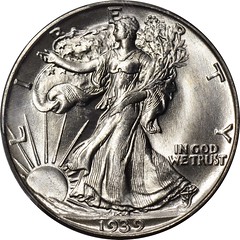 The Pennsylvania Association Of Numismatists (PAN), The American Numismatic Society (ANS) and the National Arts Club (NAC) bring together this important program to showcase the interaction between Numismatics and the Arts. Former President of the American Numismatic Association, Tom Uram and PAN Vice President Carlos Kearns (also member of the NAC) are curating the series. The goal is to bridge the arts and numismatic communities through common understanding of the richness of US coin design.
The Pennsylvania Association Of Numismatists (PAN), The American Numismatic Society (ANS) and the National Arts Club (NAC) bring together this important program to showcase the interaction between Numismatics and the Arts. Former President of the American Numismatic Association, Tom Uram and PAN Vice President Carlos Kearns (also member of the NAC) are curating the series. The goal is to bridge the arts and numismatic communities through common understanding of the richness of US coin design.
Featured this year will be the coins and artistic works of renowned designer and medalist Adolph Weinman, who created the Walking Liberty Half Dollar and Mercury Dime, two of the most beautiful US coins of the 20th century. Weinman was honored for his work by the National Arts Club in 1936. The series will include a presentation by nationally acclaimed numismatist, Dr. Jesse Kraft. An exhibit of his coins and artistic work will accompany the presentation, courtesy of The American Numismatic Society, Constantin and Jocelyn Marinescu, Gary Adkins and Carlos Kearns.
CONECA TO OFFER ERROR & VARIETY EXAMINATION
CONECA will be examining error and variety coins for free around the USA in the next few months, including the Pennsylvania Association of Numismatists (PAN) show, the Willamette Coin Club show, and the FUN show. Here is a press release. -Garrett
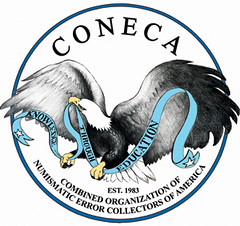 CONECA, the international error coin and variety club, will be offering free examination of error and variety coins to collectors at educational tables at coin shows across the United States throughout this year and into 2026.
CONECA, the international error coin and variety club, will be offering free examination of error and variety coins to collectors at educational tables at coin shows across the United States throughout this year and into 2026.
The club, whose name stands for "Combined Organizations of Numismatic Error Collectors of America," is the largest coin specialty club in the United States and has actively been educating collectors about mint error and variety coins for the last five decades. They would love to help you with your error coins!
At their coin show tables, different members of the CONECA Board of Directors and other error / variety enthusiasts (each with different areas of specialty as available) will offer free examination to collectors who bring coins from their collection to the show with questions. This is offered as a free service to help the hobby grow.
ERROR COIN PUBLICATION GALLERY
Greg Bennick recently published an interview with Mike Niespodzinski in ErrorScope, the official publication of The Combined Organization of Numismatic Error Collectors of America (CONECA). I was intrigued by the illustrations of various error coin books, periodicals, catalogs, price lists and ephemera, many of which I hadn't seen before. Greg kindly sent the images along for publication, and here they are in no particular order. Thank you! -Editor
VOCABULARY TERM: ROTATED DIE
Here's another entry from Dick Johnson's Encyclopedia of Coin and Medal Terminology. -Editor
Rotated Die. A striking error in which the axis of the reverse does not agree with that of the obverse. A rotated die is due to one of two causes: 1) misalignment during setup (see DIE ALIGNMENT), or 2) CHATTERING in which the dies are not secure in their chucks and turn, or rotate, during constant striking. The amount of rotation is expressed in degrees of a circle: coins (with the top of obverse to the bottom of the reverse) is 0° normal. Rotation is also expressed in clock face positions from 1 to 12, each number being 30°, as 3 o'clock is 90° off center.
MORE 1804 DOLLAR STORIES
Several readers submitted thoughts on the 1804 Dollar articles Pete Smith compiled.
-Garrett
Mike Costanzo writes:

Pete Smith's extensive listing of 1804 Dollar stories are interesting. I can remember being introduced to the legendary "King of Coins" as a kid through comic book advertising. All three ads pictured were from the coin department of Best Values Co. of Newark (and later, East Orange) New Jersey, which has long since disappeared. It's interesting to note the $9,985.00 quote is from the 1962 catalog being offered, while the $11,750.00 quote is from the 1964 and 1973 catalogs. Hard to believe the price of a 1804 Dollar had not moved during that nine year span despite the great coin boom of the 1960's. Best Values Company were obviously more interested in selling the reader a cheap catalog for $1.00 when you have purchased the latest edition of Yeoman's Red Book for $1.75. But you gotta love the tag line: "19,000 minted -only 12 accounted for - where are the rest?"
1804 DOLLAR FAKES AND REPLICAS
E-Sylum Feature Writer and American Numismatic Biographies author Pete Smith submitted this article on fakes and replicas of the 1804 Dollar. Thanks! -Editor
After my article last week, Wayne asked if anyone had a fake 1804 dollar. I found five examples in my collection. None are deceptive to an experienced numismatist.
Let's begin the discussion by establishing some terms.
No 1804 Dollar was struck at the Mint in 1804. There is no "Real" 1804 Dollar.
Dollars dated 1804 and struck in 1834-35 are generally known as "Originals." Those struck around 1858 are generally known as "Restrikes." Both terms are not appropriate but have come to be understood. They may also be called "Authentic." If it isn't authentic, it is a fake.
1804 DOLLAR OFFERED ON EBAY
Pete Smith also submitted this follow up on an 1804 Dollar offered on eBay. Thank you. See the previous article in this issue for his discussion of 1804 dollar fakes and replicas. -Editor
A new listing appeared on eBay on September 28, 2025, for a "USA Draped Bust Dollar - Heraldic Eagle – 1804." Closing date was Sunday, October 12, 2025, so you just missed it.
U.S. MINT 1804 DOLLAR IN GOLD
So what would you pay for an authentic 1804 dollar from the U.S. Mint in gold? Charles Morgan of CoinWeek discusses the "Best of the Mint Series" 'tribute' to the 1804 Dollar. Here's an excerpt - see the complete article online. -Editor
The United States Mint has proudly announced the fourth release in its exclusive "Best of the Mint Series," featuring a modern tribute to one of American numismatics' most coveted treasures: the storied 1804 Draped Bust Dollar.
Often called the "King of American Coins" for its extraordinary rarity and mystique, the 1804 Dollar is being reissued as a remarkable one-ounce, 99.99% fine gold coin, offering collectors a chance to own a piece of this legend as the nation approaches its Semiquincentennial in 2026.
SBG RICHARD AUGUST COLONIAL CURRENCY SELECTIONS
Stack's Bowers sold the Richard August Collection of U.S. Colonial Currency on October 9. Select items are discussed below. -Garrett
CT-196. Connecticut. June 7, 1776. 2 Shillings. PMG Choice Uncirculated 64 EPQ. No. 3115. Exceedingly original and laden with premium qualities. The embossing and contrast noticed on this Colonial-era note from Connecticut are just but one of the many attractive traits to be noticed. PMG comments "Cancelled."
THE DEAN OAKES COLLECTION, PART ONE
Lyn Knight is offering the Dean Oakes Collection, Part I of U.S. Type Notes. Here are some selections. -Garrett
We're excited to announce that the Dean Oakes Collection of U.S. Type Notes is now live! This impressive offering includes his exceptional collection of Large Size Type Star Notes as well as a few noteworthy Large Size Errors. These items are ready for viewing and bidding, so please double-check your credit limits in advance and contact our office for any necessary increases — we don't want you to miss out!
The notes in this collection are available in various forms — some certified by third-party grading services, and others raw, graded by Dean or myself. As someone with "older" eyes, and with years of experience seeing how one's grading ability can change over time, I understand the importance of clarity: Returns on raw notes will only be accepted for authenticity issues. If you can't attend lot viewing in person, we encourage you to send someone you trust to act as your eyes on-site.
HERITAGE: OCTOBER 2025 WORLD PAPER MONEY
Heritage Auctions will be hosting their World Paper Money Signature Auction on October 16. Select items from the Curators' Picks are discussed below. -Garrett
Belgian Congo Banque du Congo Belge, Kinshasa 1000 Francs 3.11.1920 Pick 12b PMG Extremely Fine 40. Belgian Congo banknotes have always appealed to collectors worldwide, due to their incredible designs, tropical locale, and rarity in the best of collector grades. This 1000 Francs was the highest denomination of the first full series of banknotes printed for and issued in the Belgian Congo, which includes notes from 5 Francs to 1000 Francs. At the time of cataloging, this is one of only two Kinshasa-issue 1000 Francs of this type graded in the PMG Population Report. Additionally, PMG has not graded any 1000 Francs of this design from any other city of issue. Extremely rare, as print totals were small and only a few exist to be collected today. Brief circulation, a minor corner stain, small tears, and pinholes are mentioned for accuracy. A design virtually unseen and type note definitely missing from nearly all collections.
FRED HOLABIRD'S GRAND FINALE AUCTION
Holabird Americana issued the following Press Release regarding its final sales, which will be held in October and November. -Garrett
October-November 2025 Brings the Last of an Era
 Here we are in the fall, and the mountain air here in Reno-Tahoe is spectacular at this time of year. The sunsets are frequently so colorful and majestic that we call them "Bierstadt sunsets," after the famous western landscape artist Albert Bierstadt. His western paintings can be found in many of the great American art museums from New York to Colorado to California.
Here we are in the fall, and the mountain air here in Reno-Tahoe is spectacular at this time of year. The sunsets are frequently so colorful and majestic that we call them "Bierstadt sunsets," after the famous western landscape artist Albert Bierstadt. His western paintings can be found in many of the great American art museums from New York to Colorado to California.
We've got our own form of special western paintings coming in this upcoming sale, six world-class western paintings by Dan Cody Muller, Buffalo Bill Cody's adopted son, including a painting that may have been part of the inspiration for Stan Jones song "Ghost Riders in the Sky". Don't miss my stories on these fantastic paintings when Grant and Barb send them out!
While we do have two sales left in the bucket before I formally retire from the auction business and close the company, this upcoming auction is special, and is our last live sale. I'm hoping I can convince each of our team to spend at least a few lots on the auction podium, so that you can all see, thus informally meet, the wonderful folks that work so hard together at our business. The very last sale in late November will be automated, with timed lots as we have been doing for several years.
LIVING AMERICANS ON US COINS
Paul Horner submitted this expanded list of living, The first one is an example of an unofficial coin from long before the 1866 act banning living persons from currency; others are mint products for the Philippines, one had four legs and one had no body - but it's a good list with some interesting comments and qualifications. Thanks! Great coin club conversation starter. -Editor
THE FIRST LIVING PERSON ON A ROMAN COIN
Regarding the proposed Trump coin, Peter Edwell of Australia, a professor in Ancient History, sees parallels with leaders of ancient Rome. "Trump on a coin? When Julius Caesar tried that, the Roman republic crumbled soon after." -Editor
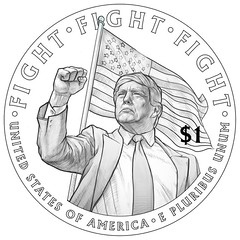 A proposed one dollar coin featuring US President Donald Trump is causing ructions across the political divide. It's also provoking discussion in the world of ancient Roman numismatics (coin studies).
A proposed one dollar coin featuring US President Donald Trump is causing ructions across the political divide. It's also provoking discussion in the world of ancient Roman numismatics (coin studies).
While only a draft proposal, the coin could be minted in 2026 to mark 250 years since the US declaration of independence. But an old law prohibits the "likeness of any living person" from being "placed upon any of the bonds, securities, notes, fractional or postal currency of the United States."
More than 2,000 years ago, the depiction of living figures on Roman coins caused similar ructions.
WOULD THE 2026 TRUMP COIN BE LEGAL?
Len Augsburger and others passed along this New York Times article about the legality of plans to picture President Trump on a semiquincentennial commemorative coin. Thanks. -Editor
The Trump administration on Monday defended its plan to mint a $1 coin bearing the image of President Trump despite the fact that an 1866 law dictates that only the deceased can appear on U.S. currency.
Initial designs for the coins released by the U.S. treasurer last week stirred controversy and accusations that the Trump administration was violating the law so that Mr. Trump could honor himself by putting his face on a coin. The 1866 law enshrined a tradition that individuals could appear on U.S. currency only posthumously to avoid the appearance that America was a monarchy.
PHILIPPINE ABACA FIBER FOR CURRENCY?
The Philippine Fiber Industry Development Authority is lobbying for the use of abaca fiber in currency manufacturing. -Editor
 The Department of Agriculture (DA)'s fiber industry development arm is exploring the use of local abaca in banknote production with French authorities, promoting its use as part of a broader effort to strengthen the country's fiber industry and expand international market opportunities.
The Department of Agriculture (DA)'s fiber industry development arm is exploring the use of local abaca in banknote production with French authorities, promoting its use as part of a broader effort to strengthen the country's fiber industry and expand international market opportunities.
The Philippine Fiber Industry Development Authority (PhilFIDA) yesterday said they held a meeting with Banque de France, the national bank of France, and officials from the French embassy to discuss the potential application of abaca in currency manufacturing.
THE 2025 GOLD RUSH
With echoes of the 1980's silver boom, the Wall Street Journal published an article about the 2025 gold rush as seen through Manhattan's Diamond District. Here's an excerpt - see the complete article online. -Editor
 So many customers flocked to a New York City gold dealer this past week that staff had to ask people to wait outside.
So many customers flocked to a New York City gold dealer this past week that staff had to ask people to wait outside.
"I'll go through this all day long," said Chief Executive Ben Tseytlin, about the people piling into his shop, Bullion Exchanges. Some were there to sell gold, but increasingly people are coming to buy, he said.
It is one of several jewelry dealers along a stretch of Manhattan known as the Diamond District, where business has been thriving as gold and silver values rise. That has brought a flood of new faces to the crowded Midtown block that holds roughly 2,600 businesses, many owned by members of New York's Orthodox Jewish community. Vendors hang out on the sidewalks to try to grab customers.
"Selling gold?" is the common cry of the street.
"Over here, buddy," said a vendor as he flashed a business card.
PAUL KRUGER'S NUMISMATIC LEGACY
On a related note, here's an article about the numismatic legacy of Paul Kruger of Krugerrand fame. -Editor
The year 2025 marks the bicentenary of the birth of Paul Kruger, a seminal figure in South African history whose legacy continues to resonate across political, cultural, and numismatic spheres.
Kruger's enduring presence in coinage has elevated him to global prominence within the field of numismatics.
According to Landon Coleske, numismatic expert and historian at Bassani's Auction House, "Paul Kruger would rank in the top 20 of people who have appeared on the most coins in history. Also, if you exclude monarchs, he'd be in the Top 5." This distinction underscores the remarkable extent to which Kruger's image has been embedded in South Africa's monetary heritage.
LOOSE CHANGE: OCTOBER 12, 2025
Here are some additional items in the media this week that may be of interest. -Editor
A Greyheet article by Michael Garofalo examines Robert Scot's Draped Bust Half Cents. Here's an excerpt - see the complete article online. -Editor
After the American Revolutionary War had ended, the new fledgling government didn't have an army, a navy, or even its own money to spend. The Coinage Act of 1792 established that the United States should create its own minting facility and to create America's own coinage.
When the Philadelphia Mint opened for business in 1793, it first struck copper coins—Half Cents and Large Cents. Coinage in America at that time was a hodgepodge of foreign coins, each with its own unique value, so buying food priced in British Pounds with Dutch Guilders became a complicated transaction. Standardized American coins would make commerce much easier to conduct.
In 1793, the Mint struck only 35,534 Half Cents, all of which bore the Liberty Cap and Pole obverse with a Wreath reverse. All of these coins were designed by the first Chief Engraver of the United States Mint, Robert Scot. He was a Scottish-American engraver who was born in 1745 in Cannongate, Scotland. He moved to Fredericksburg, Virgina in 1775 and he changed the spelling of his last name from 'Scott' to 'Scot,' to make himself seem more American. One of his earliest jobs in America was engraving plates for Virginia's colonial banknotes. Ironically, the banknotes he engraved were adorned with the Coat of Arms of Great Britain. But a year later, as the Colonies declared their independence, the British Coat of Arms was replaced with a new design representing the Commonwealth of Virginia.
To read the complete article, see:
Engraving a Nation: How Robert Scot's Draped Bust Design Defined America's Coinage
(https://www.greysheet.com/news/story/engraving-a-nation-how-robert-scots-draped-bust-design-defined-americas-coinage)
Other topics this week include a Lusitania victim's medals, and ancient artifacts found in a thrift store. -Editor
ABOUT THIS ISSUE: OCTOBER 12, 2025
Let's see, where did the week go? No races, but being off work with nice weather gave me a chance to get in a lot of walking. I won't need to upgrade my pedometer to have another digit, but it's getting a workout. I went a little farther each day, even making my way over to the W&OD Trail - "the skinniest park in Virginia." It's a 45-mile trail along the former roadbed of the Washington & Old Dominion Railroad.
Being off work has felt like a nice dry run for retirement, at least until my boss called Thursday and told me I'm being called back in next week from the government shutdown furlough. I won't get paid until *checks notes* maybe this is over, so that part's still like retirement. Or being Editor Emeritus, which Redbook Editor Emeritus Ken Bressett described as being, "you work anyway but don't get paid anymore."
Friday morning brought this retirement news:
"You'll never retire: A government panel in Germany has proposed raising the country's retirement age to 73 to prevent the collapse of their pension system. I'm a workaholic but even to me, making 73-year-olds keep working full-time seems insane. Think how long it would take them to open their emails every morning at that age?"
Opening emails is a lot of what I do in my editor's role. At first I thought an email about the "Treasures of the Occult" book was spam, but no, it was from Baldwin's and announced a legit numismatic book that sounds perfect for us E-Sylum coin freaks and weirdos. Check it out elsewhere in this issue.
Finally, here are some interesting non-numismatic articles I came across this week.
A volcanic eruption indirectly led to the invention of the bicycle.
(https://historyfacts.com/science-industry/fact/volcanic-eruption-bicycle-invention/?lctg=fc99d453-51bd-454f-b10d-ed4d7ce03f91)
David Foster Wallace Tried to Warn Us About these Eight Things
(https://www.honest-broker.com/p/david-foster-wallace-tried-to-warn)
What it looks like in the world's data center capital
(https://www.washingtonpost.com/opinions/interactive/2025/data-centers-artificial-intelligence-virginia-photos/)
-Editor

